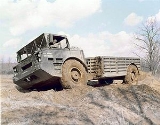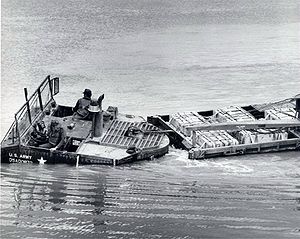
M520 Goer
Encyclopedia
The M520 'Goer' "Truck, Cargo, 8-ton, 4x4" truck series was formerly the US Army’s standard heavy tactical truck before its replacement by the HEMTT
. As trucks go, the Caterpillar 'Goer' stands out, due to being articulated
, amphibious
, overly wide and lacking suspension on the wheels.
Mid 1950s the US military were looking for a new, extreme off-road, tactical truck series, with substantially increased load-carrying capacity. According to a May 2006 article in Classic Military Vehicle magazine, the United States Armor Board began evaluating and testing commercially available, large, wheeled, articulated-steering, earth-moving equipment for potential tactical application in 1956 / 1957. This resulted in development contracts for 4x4 all-terrain vehicles of various weight classes being awarded to Clark Equipment, Le Tourneau-Westinghouse and Caterpillar Tractor Company.
Clark provided a 5-ton prototype, based on their Model 75 log-skidder, powered by a Cummins
6-cyl. Diesel engine. Caterpillar's entries were in the eight-ton class and were designated: XM520 (8-ton cargo truck), XM553 (10-ton wrecker recovering) and XM559 (8-ton, 2.500-gallon tanker) http://www.panzerbaer.de/helper/us_trk_m520_goer-a.htm. Le Tourneau-Westinghouse offered three variants in the 15-ton class: XM437 Cargo, XM438 Tanker and XM554 Wrecker.
Without exception, the prototypes consisted of two segments, housing engine and driver's compartment in the front and using the rear part as main transport unit, whereby steering was accomplished by articulating
the whole front unit relative to the rear, as opposed to pivot steering the front wheels conventionally. The large wheels with big, low-pressure tyres were mounted without any suspension or steering mechanism, greatly simplifying the design. In order to keep the wheels on the ground on uneven terrain, the front and rear units could not only swivel around a vertical axis, but also along the vehicle's longitudinal axis, allowing significant articulation.
The Caterpillar design did well in testing, and in 1960 the company was awarded a multi-million dollar contract for developing eight 8-ton cargo trucks, delivered in 1961 and 1962, as well as two 10-ton wreckers and two 2500-gallon tankers in 1962. Another twenty-three units were ordered in 1963, and field-tested in Germany in 1964, and later in Vietnam in 1966. Not until 1971 did Caterpillar eventually receive a production contract for 1300 units: 812 M520 cargo-vehicles, 371 M559 tankers and 117 M553 wreckers. Production began in 1972 and lasted through June 1976. When fitted with its own crane, the cargo variant would be designated M877.
 Not only did the Caterpillar offer extreme off-road ability, including 20° longitudinal articulation and 30° side-slopes, it was also fully amphibious, using the wheels for propulsion in the water. The rear cargo-bed tailgate and drop-side doors, that allowed rapid discharge of cargo, had watertight seals to preserve the unit's swimming capability. In the US’s involvement in the Vietnam War, the Goer developed a reputation of being able to go where other trucks could not, and it was one of the preferred resupply vehicles after the pre-production units' introduction in 1966. They achieved a 90% availability rate even though spare parts for the Goer were not an official part of the US Army inventory until 1972.
Not only did the Caterpillar offer extreme off-road ability, including 20° longitudinal articulation and 30° side-slopes, it was also fully amphibious, using the wheels for propulsion in the water. The rear cargo-bed tailgate and drop-side doors, that allowed rapid discharge of cargo, had watertight seals to preserve the unit's swimming capability. In the US’s involvement in the Vietnam War, the Goer developed a reputation of being able to go where other trucks could not, and it was one of the preferred resupply vehicles after the pre-production units' introduction in 1966. They achieved a 90% availability rate even though spare parts for the Goer were not an official part of the US Army inventory until 1972.
Nevertheless the vehicle's lack of suspension made it too bouncy on hardened surfaces, making most drivers shy away from its 31 mph (50 km/h) top speed. The method for keeping bounce to a minimum on hard roads was to gently sway the vehicle left and right at top speed. The bilge pumps were often abused on hard road convoys as "super-squirters" by bored drivers as they would accumulate water in the hull and drivers soon realized havoc could be raised by turning on the high volume pumps to douse passing and oncoming traffic. The oscillating cab was also dangerous as entering or exiting the vehicle with the engine off could put pressure on the steering wheel and when the engine was started the cab would turn without warning. Also its oversize dimensions proved generally awkward, so in the 1980s it was replaced by the Oshkosh Heavy Expanded Mobility Tactical Truck series, that combined good on-road behavior with adequate off-road performance. As the Goers were surplused accordingly, it was done so under a demilitarization order similar to that of the M151 MUTT jeep. Core components in the steering and driveline were destroyed before the remains of the vehicle were sold off. Consequently only very few vehicles remained in existence, in museums and private collections.
Heavy Expanded Mobility Tactical Truck
The Heavy Expanded Mobility Tactical Truck series is a range of eight-wheel drive diesel-powered off-road capable trucks, used by the US military. Formally described as "Truck, Cargo: 10-Ton, 8x8", it has been nicknamed the "Dragon Wagon". HEMTT trucks first went into service with the U.S...
. As trucks go, the Caterpillar 'Goer' stands out, due to being articulated
Articulated vehicle
An articulated vehicle is a vehicle which has a permanent or semi-permanent pivoting joint in its construction, allowing the vehicle to turn more sharply. There are many kinds of articulated vehicles, from heavy equipment to buses, trams and trains...
, amphibious
Amphibious vehicle
An amphibious vehicle , is a vehicle or craft, that is a means of transport, viable on land as well as on water – just like an amphibian....
, overly wide and lacking suspension on the wheels.
Mid 1950s the US military were looking for a new, extreme off-road, tactical truck series, with substantially increased load-carrying capacity. According to a May 2006 article in Classic Military Vehicle magazine, the United States Armor Board began evaluating and testing commercially available, large, wheeled, articulated-steering, earth-moving equipment for potential tactical application in 1956 / 1957. This resulted in development contracts for 4x4 all-terrain vehicles of various weight classes being awarded to Clark Equipment, Le Tourneau-Westinghouse and Caterpillar Tractor Company.
Clark provided a 5-ton prototype, based on their Model 75 log-skidder, powered by a Cummins
Cummins
Cummins Inc. is a Fortune 500 corporation that designs, manufactures, distributes and services engines and related technologies, including fuel systems, controls, air handling, filtration, emission control and electrical power generation systems...
6-cyl. Diesel engine. Caterpillar's entries were in the eight-ton class and were designated: XM520 (8-ton cargo truck), XM553 (10-ton wrecker recovering) and XM559 (8-ton, 2.500-gallon tanker) http://www.panzerbaer.de/helper/us_trk_m520_goer-a.htm. Le Tourneau-Westinghouse offered three variants in the 15-ton class: XM437 Cargo, XM438 Tanker and XM554 Wrecker.
Without exception, the prototypes consisted of two segments, housing engine and driver's compartment in the front and using the rear part as main transport unit, whereby steering was accomplished by articulating
Articulated vehicle
An articulated vehicle is a vehicle which has a permanent or semi-permanent pivoting joint in its construction, allowing the vehicle to turn more sharply. There are many kinds of articulated vehicles, from heavy equipment to buses, trams and trains...
the whole front unit relative to the rear, as opposed to pivot steering the front wheels conventionally. The large wheels with big, low-pressure tyres were mounted without any suspension or steering mechanism, greatly simplifying the design. In order to keep the wheels on the ground on uneven terrain, the front and rear units could not only swivel around a vertical axis, but also along the vehicle's longitudinal axis, allowing significant articulation.
The Caterpillar design did well in testing, and in 1960 the company was awarded a multi-million dollar contract for developing eight 8-ton cargo trucks, delivered in 1961 and 1962, as well as two 10-ton wreckers and two 2500-gallon tankers in 1962. Another twenty-three units were ordered in 1963, and field-tested in Germany in 1964, and later in Vietnam in 1966. Not until 1971 did Caterpillar eventually receive a production contract for 1300 units: 812 M520 cargo-vehicles, 371 M559 tankers and 117 M553 wreckers. Production began in 1972 and lasted through June 1976. When fitted with its own crane, the cargo variant would be designated M877.

Nevertheless the vehicle's lack of suspension made it too bouncy on hardened surfaces, making most drivers shy away from its 31 mph (50 km/h) top speed. The method for keeping bounce to a minimum on hard roads was to gently sway the vehicle left and right at top speed. The bilge pumps were often abused on hard road convoys as "super-squirters" by bored drivers as they would accumulate water in the hull and drivers soon realized havoc could be raised by turning on the high volume pumps to douse passing and oncoming traffic. The oscillating cab was also dangerous as entering or exiting the vehicle with the engine off could put pressure on the steering wheel and when the engine was started the cab would turn without warning. Also its oversize dimensions proved generally awkward, so in the 1980s it was replaced by the Oshkosh Heavy Expanded Mobility Tactical Truck series, that combined good on-road behavior with adequate off-road performance. As the Goers were surplused accordingly, it was done so under a demilitarization order similar to that of the M151 MUTT jeep. Core components in the steering and driveline were destroyed before the remains of the vehicle were sold off. Consequently only very few vehicles remained in existence, in museums and private collections.

